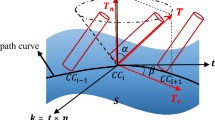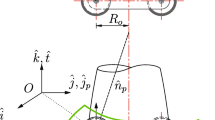Abstract
This article introduces a new torus cutter positioning strategy for five-axis milling of free-form surfaces. This approach ensures elimination of local interference while also allowing better surface quality to be obtained than with positioning proposed by computer-aided manufacturing (CAM) software. In practice, the cutter axis is inclined to the rear in relation to the feed movement. A first inclination for the cutter axis is calculated to allow local interference to be eliminated. Then, an additional inclination is given to tool axis to achieve balancing of the transversal cutting force component perpendicular to the plane containing the tool axis and the feedrate vector. This particular machining situation considerably enhances the cutter's dynamic behaviour and gives better roughness values than those obtained with positioning by CAM software. A positioning method is adapted to the negative rearward inclination of the cutter axis, and it is then shown how transversal cutting force balancing is integrated in the form of an additional inclination. Finally, a comparison of the results obtained after milling with this new positioning and positioning calculated by a CAM program highlights the new method’s advantages.
Similar content being viewed by others
References
Gilles P, Monies F, Rubio W (2006) Modelling cutting forces in milling on torus cutters. Int J Mach Mach Mater 1(N 2):166–185
Gilles P, Monies F, Rubio W (2007) Optimum orientation of a torus milling cutter: method to balance the transversal cutting force. Int J Mach Tool Manuf 47(15):2263–2272
Gilles P, Cohen G, Monies F, Rubio W. Dynamic behaviour improvement for a torus milling cutter using balance of the transversal cutting force. Int J Adv Manuf Tech 40(7–8):669–675. doi:10.1007/s00170-008-1380-1
Kruth JP, Klewais P (1994) Optimization and dynamic adaptation of the cutter inclination during five-axis milling of sculptured surfaces. Annals of the CIRP, 43
Jensen CG, Red WE, Pi J (2002) Tool selection for five-axis curvature matched machining. Comput Aided Des 34(3):251–266
Marciniak K (1987) Influence of surface shape on admissible tool positions in 5-axis face milling. Comput Aided Des 19(5):233–236
Chen T, Ye P, Wang J (2005) Local interference detection and avoidance in five-axis NC machining of sculptured surfaces. Int J Adv Manuf Tech 25(3–4):343–349
Lee Y-S (1997) Admissible tool orientation control of gouging avoidance for 5-axis complex surface machining. Comput Aided Des 29(7):507–521
Rubio W (1993) Génération de trajectoires du centre de l'outil pour l'usinage de surfaces complexes sur machines à trois et cinq axes. Thèse de doctorat, Université Paul Sabatier, Toulouse III
Redonnet J-M, Rubio W, Monies F, Dessein G (2000) Optimising tool positioning for end-mill machining of free-form surfaces on 5-axis machines for both semi-finishing and finishing. Int J Adv Manuf Tech 16(6):383–391
Monies F (2001) Positionnements hors interférence pour l’usinage en bout et en roulant de formes gauches. Thèse de doctorat, Université Paul Sabatier, Toulouse III
Warkentin A, Ismail F, Bedi S (2000) Multi-point tool positioning strategy for 5-axis machining of sculptured surfaces. Comput Aided Geom Des 17(1):83–100
Gray P, Bedi S, Ismail F (2003) Rolling ball method for 5-axis surface machining. Comput Aided Des 35(4):347–357
Gray PJ, Bedi S, Ismail F (2005) Arc-intersect method for 5-axis tool positioning. Comput Aided Des 37(7):663–674
Li Z, Chen W (2006) A global cutter positioning method for multi-axis machining of sculptured surfaces. Int J Adv Manuf Tech 46(12-13):1428–1434
Fan J, Ball A (2008) Quadric method for cutter orientation in five-axis sculptured surface machining. Int J Mach Tools Manuf 48(7-8):788–801
Patrick G, Johanna S, Stéphane S, Frederic M, Walter R (2011) Determination of angular fields outside low and high collisions to mill free-form surfaces on 5-axis CNC machines. Int J Prod Res. doi:10.1080/00207543.2010.549519, TPRS-2010-IJPR-0224.R2
Monies F, Mousseigne M, Redonnet J-M, Rubio W (2004) Determining a collision-free domain for the tool in five axis machining. Int J Prod Res 42(21):4513–4530
Cohen G, Gilles P, Segonds S, Mousseigne M, Lagarrigue P. Thermal and mechanical modelling during dry turning operations. Int J Adv Manuf Tech 58(1–4):133–140. doi:10.1007/s00170-011-3372-9
Author information
Authors and Affiliations
Corresponding author
Rights and permissions
About this article
Cite this article
Gilles, P., Cohen, G., Monies, F. et al. Torus cutter positioning in five-axis milling using balance of the transversal cutting force. Int J Adv Manuf Technol 66, 965–973 (2013). https://doi.org/10.1007/s00170-012-4381-z
Received:
Accepted:
Published:
Issue Date:
DOI: https://doi.org/10.1007/s00170-012-4381-z




